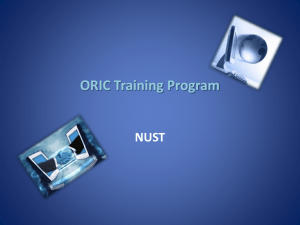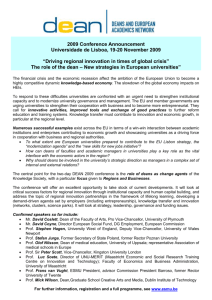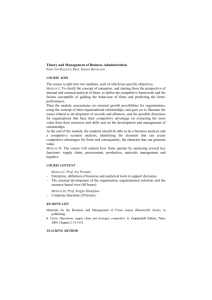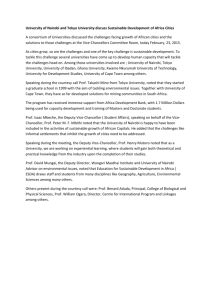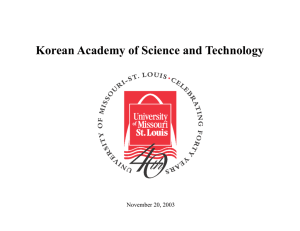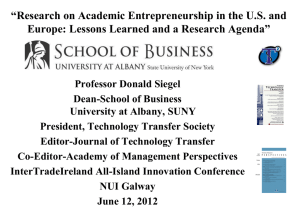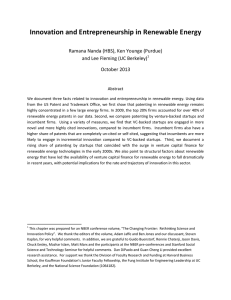Japanese Manufacturing FDI and International Production and
advertisement
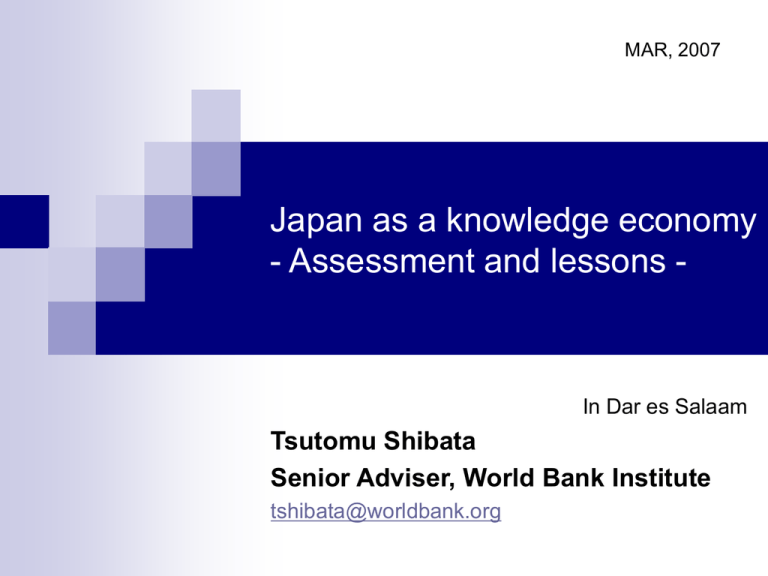
MAR, 2007 Japan as a knowledge economy - Assessment and lessons - In Dar es Salaam Tsutomu Shibata Senior Adviser, World Bank Institute tshibata@worldbank.org Why focus on knowledge Economy now? •A “knowledge revolution”! Speed-up in creation and dissemination of knowledge. •More opportunities for leapfrogging, but also raising risks that all countries may fall behind unless they take advantage of the new era. •Many definitions of the “Knowledge Economy” focus only on IT and high technology sectors 2 The Four Pillars of the Knowledge Economy Economic and Institutional Regime Information Infrastructure Education Innovation 3 WBI Knowledge for Development Outline Japan, Moving Toward a More Advanced Knowledge Economy Volume 1: Assessment and Lessons Volume 2: Advanced Knowledge Creating Companies (Hitotsubashi ICS) 4 Volume II (Industries &Firms) Chapter 1. Chapter 2. Chapter 3. Chapter 4. Chapter 5. Chapter 6. Chapter 7. The New Dynamism of the Knowledge-Creating Company (Prof. Takeuchi) Knowledge Creation in the Convenience Store Industry: Seven-Eleven Japan (Prof. Ikujiro Nonaka) Learning and the Self-Renewing, Network Organization:Toyota and Lexus Dealers (Prof. Emi Osono) Strategic Management of Knowledge-Based Competence: Sharp Corporation (Prof. Ichijo) Invisible Dimensions of Differentiation: Japanese Electronics Companies (Prof. Kusunoki) Inter-Organizational Knowledge Creation at Shimano (Prof. Takeuchi) Creating the Dynamics of Hard-to-Imitate Innovation (Prof. Takeuchi) 5 Why Japan? Why Japan now? 1. 2. 3. The tremendous speed and resilience Japanese industries had shown in catching up with the industrial world and overcoming the oil and Yen shocks. Japan still has many strong leaders in some industries due to the advanced manufacturing process despite the overall decline of its competitiveness. Imbalance between these strong industries/companies and weak industries. 7 Japan’s Competitiveness IMD Ranking 1989 1 1993 1 2002 30 2006 17 Is this right evaluation? 8 Japan’s Competitiveness Ranking 1989 1 1993 1 profit ratio* 6.1% 2.7% ROE 8.5% 1.7% *Operational profit ratio for 691 firms 9 Knowledge Assessment methodology (KAM) Score Card: Japan and U.S. 10 11 12 13 14 年 15 16 Japan’s National Innovation System Technology Imported* Final products => ‘reverse engineering’ Components => at first imported for knockdown, then substituted by domestic production Licensing *Model for Japan/Korea/Taiwan (VS FDI model : Singapore/Thai/Malaysia) 18 The Role of Government Education: (the school system + willingness to learn) Infrastructure: including commercial code, patent, and other legal systems. Research: national research institutes, and universities Subsidies and tax concession Gov fund in R&D—not large (20% -2000, US 28%) 19 The Business System in the past Friendly shareholders and internally-promoted managers. Pursuit of long-run goals. Long-term employment with internal training and rotation. Long-term assembler-supplier relationship Sharing of information, joint R&D. Flexibility in rearranging workshops and the nurture of workers’ broad skills. Easier introduction of new technologies. 20 Changing Business Environment Weakening of stable shareholders Occurrence of hostile M&As Occurrence of bankruptcy and worker dismissal Loss of production skills, caused by the overseas shift of production 21 Changing Economic Situations End of catch-up Strict enforcement of intellectual property rights by foreign companies => Difficulty in acquiring overseas technologies IT Revolution/Globalization Declining rate of new business establishment 5.8% (1975-78) to 3.1% (1999-2001) Now, lower than the exit rate (4.5%) 22 Need to Advance Science-Based Industries Development is pursued with innovations based on sciences Industrializing the outcome of scientific research Applying sciences to solve bottlenecks in R&D and production 23 Important Features of ScienceBased Industries Science linkages (Increasing citation of scientific papers in US patents) Diversity and change in the Boundary of the Firm (cannot perform R&D alone) University-industry collaborations Inter-firm alliances Intellectual Property Rights (returns for inventors ) Widespread use of the technology across industries 24 University-Industry (UI) Collaboration Encouragement of UI joint research Tax concessions granted to company R&D for UI Universities facilities for UI joint research / startups’ rent Encouragement of university spin-offs New startups: 11 in 1995 to 600 in 2005 (much less than in US) Patent fees are reduced for university inventions Technology licensing offices (TLOs) were established to promote patenting and licensing No. increased (national universities): 1139 in 1990 => 4029 in 2000 42 TLOs as of July 2006 Deregulation on professors’ assuming company directorship 280 professors (of national universities) allowed to become directors or auditors of companies (as of 9/2003) 25 National University Corporation Law In 2004, all national universities became semiindependent organizations. Financially, still dependent on the government. More freedom in decision-making More incentive for UI collaborations University can own patents Possibilities of hiring specialists for patenting, licensing, spinning off, etc. More incentive for collecting private funds for research. 26 Intellectual Property Reform Basic Law on IP, 2002 IP Policy Headquarters in the Cabinet Promotion of use of patent Only 27% of patents are currently used Stronger enforcement of patents Plan to establish a special court for patent litigation 27 Promotion of Startups The Law for Facilitating the Creation of New Business, 1999 Subsidies and guarantees for SMEs to start new businesses and to develop and commercialize new technologies. Tax advantages (‘the Angel Tax’) Reduction of minimum capital for a new stock company: 1 million yen => 1 yen Stock options as a compensation scheme 28 Increasing High-Tech Startups Increase in biotechnology startups 60 in 1998 => 387 in 2003 Increase in IPOs About 100 such IPOs in 2003 in three markets 29 Issues of new firms --Recruitment Two main barriers Financing (Many VC were established) Recruitment of staff Difficulty in recruitment is deep-rooted because of the Japanese employment system Many talents are in big firms Long-term worker-company attachment Still, a number of conspicuous cases have started to appear 30 Japan’s Education System Overview of Japan’s Education System 90% completion of K12 since mid 1970s. 70% of secondary education graduates go to higher education. Strong in engineering and technology education/research. Extraordinary low drop-out rate of univ’ Negligence of academic achievement Establishment of professional school system (law, business) as new trials. 32 Traditional career development in LT employment Universities had critical influences on the initial entrance to labor market. Personnel divisions control career path Different labor markets for large enterprises and for SMEs. Stress on ‘trainability’ (general skill) at recruitment, and on company specific skills, tacit skills, OJT, Seniority, etc. Strong knowledge/skill infrastructure based on the national language. 33 Changing environment (1) Deterioration of knowledge infrastructure supported by entrance exam system. Over supply of HE since 1990—end of exam hells. Reduction of school curriculum aiming for fostering creativity. Restructuring of Japanese industry Outward FDI of manufacturing Higher end products and Designs still remain in Japan, but uncertain in the long run. 34 Changing environment (2) Changes in East Asia. Chinese growth. Stronger market power of English speaking countries in the knowledge industries including education. Increasing reliance on service sector in industrialized countries. Changed preference of young workers. Lost trust in the sustainability of big companies. Increasing : Job changes in the initial career stage Popularity of foreign affiliated enterprises outsourcing and freelancers 35 CONCLUSION Economic Regime-Related Lessons and Implications Better supervision of the financial sector and more accurate disclosure of NPLs. More transparency and less crossshareholding would have facilitated countermeasures, including changing managers accountable for bad performance. Reduction of public works in rural areas and of agricultural subsidies for more balanced and flexible budgets. 37 Labor-Related Lessons and Recommendations Higher mobility and flexibility in the labor market based on more lifetime learning and re-entry, especially for women. Increase of value-added per worker through innovation is crucial. Greater availability of daycare at a reasonable cost, flexible work hours, and liberal leave policies to encourage more female work-force to be in the market. 38 IT-Related Lessons and Implications IT investment must be accompanied by proper changes in organization and work practice. Speed, selection, concentration, and collaboration are core for IT strategy. To achieve speed, firms must concentrate on core competencies. 39 Human-Resource-Related Lessons and Implications Literacy and general education were key factors in the early development of Japan. Capacity development can be enhanced by company-provided training and voluntary initiatives by workers. Globalization and the IT revolution require continuous adjustment in the business skills and educational/training systems. 40 Innovation-Related Lessons and Recommendations R&D funding by the gov’ needs to be prioritized and well-coordinated among ministries. The US National Institutes of Health can be a model. Closer collaboration between universities and industries is needed in patent licensing and joint research. Creation of a support system for entrepreneurs, consultants, accountants, and lawyers familiar with advanced technology and IPR should be encouraged. 41

